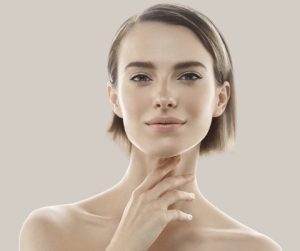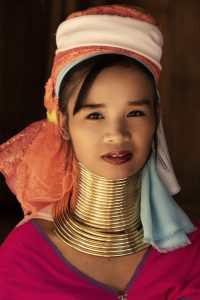Why Are Some People’s Necks Longer Than Others?
In Western Culture, long necks are seen as desirable. Are some necks actually longer than others?
 The answer is yes and no.
The answer is yes and no.
The length of a person’s neck is primarily determined by the individual’s anatomical structure and genetic factors. The neck’s length is mainly determined by the number and size of the vertebrae, the bones that make up the spinal column in the neck region.
In most people, the neck consists of seven cervical vertebrae, numbered C1 to C7. But there can be natural variations in the length of the neck due to genetic factors and individual variations in bone size and shape. These differences in length are typically within a normal range and don’t usually cause any significant functional issues or health concerns.
But it’s worth mentioning that some individuals may have conditions or disorders that can affect the length or shape of their neck, such as cervical spine abnormalities or congenital disorders. These conditions are relatively rare and usually require medical attention and specialized treatment.
Why do models appear to have longer necks than the average population?
The perception that models have longer necks than the average population can be attributed to a combination of factors related to photography, fashion industry preferences, and body posture.
- Photography techniques: Photographers often use specific angles, lighting, and posing techniques to create the illusion of longer necks. By adjusting camera angles and shooting from a slightly higher position, the neck can appear elongated in photos.
- Fashion industry preferences: The fashion industry often values certain aesthetic features, including a long and slender neck. Models are selected based on specific criteria, and individuals with naturally longer necks may be more likely to meet those criteria. This selection process can contribute to the perception that models generally have longer necks.
- Posture and body awareness: Models are trained how to pose by elongating their posture, lifting their chins, and creating a more pronounced neck-to-shoulder angle. These techniques can create the impression of a longer neck.
The appearance of longer necks in models is often influenced by external factors and the specific requirements of the fashion industry. The perceived longer necks are not necessarily indicative of anatomical differences or medical conditions.
What about the African and Asian tribes where women put rings around their necks to elongate them? What problems does this cause?
This practice is commonly associated with the  and the Kayan Lahwi people of Asia. These women traditionally wear brass rings around their necks, creating the illusion of an elongated neck.
and the Kayan Lahwi people of Asia. These women traditionally wear brass rings around their necks, creating the illusion of an elongated neck.
While the appearance of elongated necks may be visually striking, the neck itself is not actually lengthened. Instead, the brass rings push down the collarbone and compress the upper rib cage, creating the illusion of a longer neck. The rings are worn from an early age, and additional rings are added over time to increase the number and height of the rings.
The tradition of wearing neck rings is deeply rooted in these cultures and has historical and symbolic significance.
However, there are potential health risks and issues associated with this practice:
- Muscular atrophy: The continuous pressure from the rings on the collarbone and upper rib cage can weaken the supporting muscles of the neck. Over time, this can lead to muscle atrophy and decreased muscle strength.
- Limited mobility: The weight and structure of the rings restrict the movement of the neck, limiting its range of motion. This restriction can affect daily activities and overall neck flexibility.
- Compression of vital structures: The rings can compress the underlying blood vessels and nerves, potentially leading to circulatory problems and nerve compression syndromes. This compression can cause discomfort, numbness, tingling sensations, and weakness in the neck and upper extremities.
- Dependence on the rings: Long-term wearing of the rings can create dependence on them. Removing the rings after years of continuous wear can lead to postural problems and discomfort due to weakened neck muscles and altered skeletal alignment.
When did the beauty preference for long necks begin?
The preference for long necks as a beauty standard has roots in various cultures and historical periods. But beauty ideals and preferences can vary significantly across different societies and time periods. And beauty standards are subjective, cultural, and can evolve over time.
Here are a few examples of cultures and eras where long necks were considered desirable:
- Ancient Egypt: In ancient Egyptian, an elongated neck was considered a symbol of beauty and grace. Both men and women wore collars and accessories that accentuated the length of their necks. The elongation of the neck was associated with nobility and high social status.
- Kayan Lahwi Tribe: The Kayan Lahwi tribe, as mentioned earlier, has a cultural tradition of wearing neck rings to create the illusion of an elongated neck. This practice is rooted in their beliefs about beauty, identity, and cultural heritage.
- East Asia: In certain East Asian cultures, including parts of China and Thailand, a long, slender neck has been traditionally associated with femininity and gracefulness. This beauty preference can be observed in art, literature, and historical accounts.
- Western Influence: In more recent times, Western media and fashion industries have played a significant role in shaping beauty standards globally. Models and celebrities who possess long, slender necks are often seen as epitomizing elegance and attractiveness, which can influence beauty ideals in various cultures.
While long necks may have been favored in certain historical periods or regions, beauty preferences can vary widely across cultures and are influenced by a multitude of factors, including societal norms, media representation, and personal preferences. That said, it’s important to promote body positivity, inclusivity, and the appreciation of diverse physical attributes.
If you have any concerns about your neck length or spinal health, it’s always advisable to consult with a qualified healthcare professional, such as an orthopedic specialist or a spine surgeon, who can provide a thorough evaluation and personalized advice based on your specific situation.
